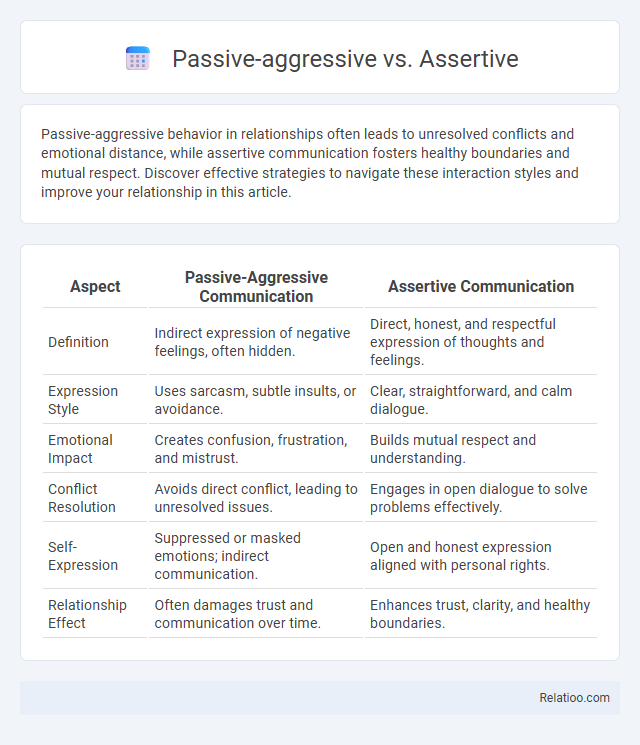Passive-aggressive behavior in relationships often leads to unresolved conflicts and emotional distance, while assertive communication fosters healthy boundaries and mutual respect. Discover effective strategies to navigate these interaction styles and improve your relationship in this article.
Table of Comparison
| Aspect | Passive-Aggressive Communication | Assertive Communication |
|---|---|---|
| Definition | Indirect expression of negative feelings, often hidden. | Direct, honest, and respectful expression of thoughts and feelings. |
| Expression Style | Uses sarcasm, subtle insults, or avoidance. | Clear, straightforward, and calm dialogue. |
| Emotional Impact | Creates confusion, frustration, and mistrust. | Builds mutual respect and understanding. |
| Conflict Resolution | Avoids direct conflict, leading to unresolved issues. | Engages in open dialogue to solve problems effectively. |
| Self-Expression | Suppressed or masked emotions; indirect communication. | Open and honest expression aligned with personal rights. |
| Relationship Effect | Often damages trust and communication over time. | Enhances trust, clarity, and healthy boundaries. |
Understanding Passive-Aggressive Behavior
Understanding passive-aggressive behavior involves recognizing indirect expressions of hostility, such as sarcasm, procrastination, or subtle sabotage. Unlike assertive communication, which clearly and respectfully expresses your needs and boundaries, passive-aggressive behavior masks true feelings and undermines effective dialogue. Identifying these patterns helps you address conflicts productively and promotes healthier interpersonal relationships.
What Is Assertive Communication?
Assertive communication involves expressing your thoughts, feelings, and needs clearly and respectfully without violating others' rights. It balances confidence with empathy, enabling constructive dialogue and effective conflict resolution. Unlike passive-aggressive or purely passive styles, assertiveness promotes honesty and directness while maintaining mutual respect.
Key Differences: Passive-Aggressive vs Assertive
Passive-aggressive communication hides resentment behind indirect behavior, while assertive communication directly and respectfully expresses your thoughts and feelings. Key differences include clarity and intention: assertiveness aims for honest expression and mutual understanding, whereas passive-aggressiveness relies on ambiguity and avoidance, often leading to confusion and conflict. Recognizing these styles helps you foster healthier interactions and self-expression.
Signs of Passive-Aggressive Communication
Signs of passive-aggressive communication include indirect resistance, such as procrastination, sarcasm, or subtle backhanded comments that mask true feelings. Your interactions may feel confusing or tense as this behavior avoids direct confrontation while expressing hidden resentment. Understanding these signs helps distinguish passive-aggressive communication from assertive communication, which involves clear, honest expression of thoughts and feelings.
Recognizing Assertive Responses
Recognizing assertive responses involves identifying clear, direct communication that respects both the speaker's and listener's rights without aggression or submission. Assertive statements use "I" language to express feelings and needs confidently while maintaining politeness and openness to dialogue. In contrast, passive-aggressive responses often disguise frustration with sarcasm or indirectness, and passive communication tends to avoid confrontation, leading to suppressed emotions and unmet needs.
Impact on Relationships: Passive-Aggressive vs Assertive
Passive-aggressive communication often leads to misunderstandings and resentment in relationships due to indirect expression of feelings, causing frustration and mistrust. Assertive communication, by contrast, fosters clarity and respect, enabling healthier, more transparent interactions that strengthen trust and mutual understanding. Your ability to choose assertiveness over passive-aggressiveness can significantly improve relationship dynamics and emotional well-being.
Psychological Roots of Passive-Aggressive Behavior
Passive-aggressive behavior stems from unresolved emotional conflicts and fear of direct confrontation, often rooted in feelings of powerlessness and low self-esteem. Unlike assertive individuals who express thoughts and needs openly and respectfully, passive-aggressive people resort to indirect resistance and subtle sabotage. Understanding your tendencies can help break the cycle and foster healthier communication patterns.
Benefits of Assertiveness in Daily Life
Assertiveness empowers individuals to communicate needs and boundaries clearly, fostering mutual respect and reducing misunderstandings. Unlike passive-aggressive behavior, which can create tension and confusion, assertive communication promotes transparency and problem-solving. Developing assertiveness enhances emotional intelligence, boosting confidence and improving interpersonal relationships in both personal and professional settings.
How to Shift from Passive-Aggressive to Assertive
Recognizing passive-aggressive behavior as indirect and harmful is the first step toward shifting to assertive communication, which emphasizes clear, honest, and respectful expression of your thoughts and feelings. You can develop assertiveness by practicing direct statements, using "I" language, setting boundaries, and addressing conflicts openly without blame. Consistent effort to replace avoidance and sarcasm with transparency promotes healthier interactions and personal empowerment.
Practical Strategies for Building Assertive Communication
Effective assertive communication hinges on clear, respectful expression of your needs without aggression or submission, promoting mutual understanding. Practical strategies include using "I" statements to express feelings, maintaining eye contact, and setting firm boundaries while remaining open to dialogue. Developing these habits helps you navigate conflicts constructively, avoiding the pitfalls of passive-aggressive or purely passive behaviors.

Infographic: Passive-aggressive vs Assertive
 relatioo.com
relatioo.com